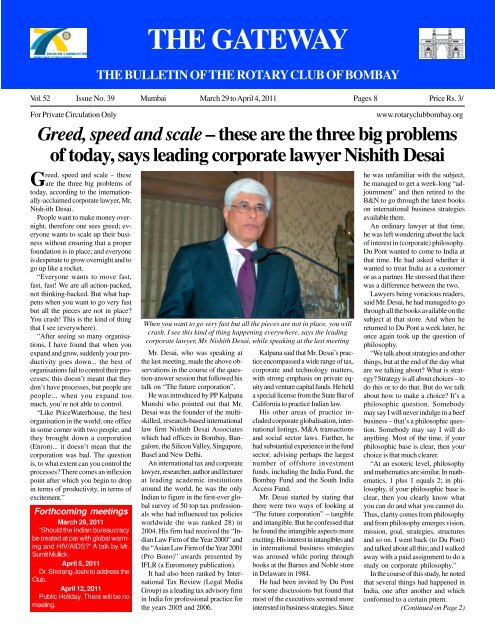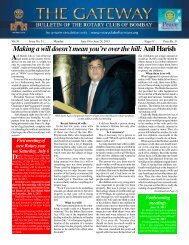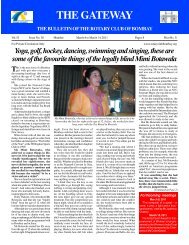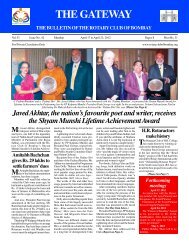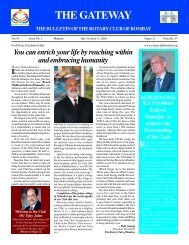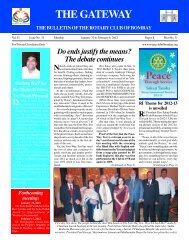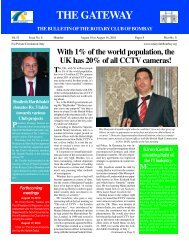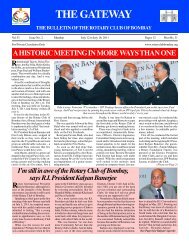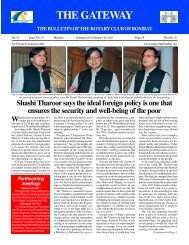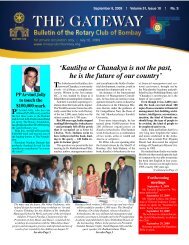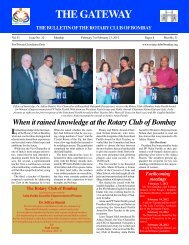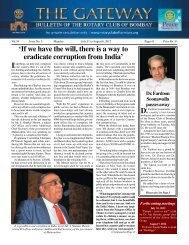You also want an ePaper? Increase the reach of your titles
YUMPU automatically turns print PDFs into web optimized ePapers that Google loves.
‘If you enter any field, be a change agent; otherwise, don’tget into it’: This is Nishith Desai’s basic philosophy(Continued from Page 1)Coca Cola had walked out becauseit was not willing to accept anythingless than 100% ownership (<strong>of</strong> its operationsin the country). And Pepsihad walked in. One had vacated themarket and another had come in.Similarly, IBM had walked out;Burroughs had come in. Pfizer haddiluted to the extent <strong>of</strong> 74% and remaineda FERA company; Ciba diluted40%, became an Indian companyand expanded faster.Mr. Desai said as his interest incorporate philosophy and strategygrew, his practice in the US also grew.unhappy. But if there was a difference<strong>of</strong> even one rupee, it was themanager’s job to communicate thereason for the difference. And the earlierthis was done, the better.It was <strong>of</strong>ten said that the old, feudalisticmodel was bad because it involved“command and control” methods.This was indeed true. The advent<strong>of</strong> new situations and <strong>of</strong> newtechnologies had speeded up the process<strong>of</strong> evolution and a “democratic”organisation was the next level. It wasalready visible in the shape <strong>of</strong> lesserhierarchy in technological companies.As for the (ever increasing) valuations<strong>of</strong> companies, these changesAnd in 1986, the head (legal) and theMD <strong>of</strong> Bears & Sterns (“which laterThe well-know management guru, the late Mr. C.K. Prahlad, was his closewere occurring on account <strong>of</strong> corporategovernance; the available statis-went down”), suggested that he setfriend and he had learned a lot from him, admits Mr. Nishith Desai at theup a law firm. Sceptical at first becauselast meetingtics had borne this out.in India counsels never set uplaw firms, he benefited from his experienceas a researcher, embarked ona study <strong>of</strong> law firm management andfinally took the plunge.Although there were manypeople who helped him in his venture,the most important contributionwas made by the well-knowmanagement guru, the late Mr.C.K. Prahlad, who was his closefriend and from whom he hadlearned a lot.The approach that he adopted tosteer his law firm was clear from thevery beginning – to make it researchbasedand to provide what he called“thought leadership”. However, thefundamental philosophy was this: “Ifyou enter any field, be a change agent;otherwise, don’t get into it.” A lot <strong>of</strong>research went into seeing whether itwould be possible to bring aboutchanges in any industry that it venturedinto.There was a time, said Mr. Desai,when there was a lot <strong>of</strong> black moneyand “mafia money” in Bollywood (theHindi film industry). On studying theissue, it was observed that the primaryproblem was the lack <strong>of</strong> industrystatus for the film industry because<strong>of</strong> which banks were unwillingto fund film-making.Once this situation was addressed(and the film industry received thedesired status), many changes cameabout. Today, corporates were goinginto film-making and nobody talkedabout “mafia money” in the movies.The second philosophy that hislaw firm adopted came about after itrecognised the fact that every newtechnology, every new financial instrumentand every new businessmodel brought along legal or tax problems.If the firm used its legal and taxcells to mull over and came up withsolutions for futuristic problems, itwould do well.And so it was that it studied, researchedand brain-stormed on futuretechnologies such as Wi-Fi, quantumcomputing, nano-technology, fuelcells, cloud computing and so on andmade forecasts four to six years ahead<strong>of</strong> time.Returning to the subject <strong>of</strong> “Thefuture corporation”, Mr. Desai saidthat his research and studies had madehim an ardent student <strong>of</strong> organisationalbehaviour. But the more hethought about technical aspects, themore he realised that these were secondaryand that the most importantthing was developing a new-age businessmodel.“I thought and thought and thought.Can we move from the traditional,feudalistic model <strong>of</strong> a corporation,that is, command and control, to amore democratic model? Can we combinedemocratic principles with corporates,with organisations?”The one principle (from a managementperspective) that came up immediatelywas Mahatma Gandhi’sphilosophy <strong>of</strong> trusteeship; there wasalso Charles Henley’s philosophy <strong>of</strong>trusteeship.While the Mahatma, when hespoke <strong>of</strong> trusteeship, said that “whenyou create wealth you are a trustee<strong>of</strong> that wealth” (external trusteeship),Charles Henley wrote a lot <strong>of</strong> paperson virtual organisations and said(when) you cannot see people workingaround you, you have to manageby trust (trust and manage peopleby information rather than controlprocesses).From this evolved the three-foldprinciple – the freedom to think,the freedom to act and the freedomto earn. If these three factorswere incorporated in an organisation,that would be the next level<strong>of</strong> evolution. But was this feasible?Would a company allow its employeesto choose their salary?The inclusion <strong>of</strong> these three elementswould help in the evolution <strong>of</strong>a new and different kind <strong>of</strong> organisation.“You get the best practices todayfrom the best managementschools abroad, but if you can combinethe trusteeship principle and theprinciple <strong>of</strong> freedom to think, to actand to earn, that would be interesting.”Mr. Desai revealed that he developedhis own law firm on this newlyevolvedprinciple.“And it has really worked. We askpeople how much they want. Everyonein the firm is given the accounts,there is complete transparency andeverybody has the right to ask anyquestion; there is freedom <strong>of</strong> informationnot only outside but also insidethe firm. If I go for a haircut,people will know and will ask, whyare you going to the Taj or the President?I will justify (my decision), butthey can ask.”When it came to compensation, theeasiest thing was to give the samepackage to two similar persons inorder not to make one or the other“What about the next evolution?I think we’re going to go towardsethical corporations. Myrole as a lawyer, as complianceadviser or otherwise, will move toethics. That will be our role in thenext ten years. It’s a very trickysubject, but that’s the thing that Isee evolving.”Mr. Desai then turned to some keyfactors that would define future corporations.Apart from “democratisation”,there would have to be a certainspeed in the decision-makingprocess and a lot <strong>of</strong> creativity, too.Often, it was noted that disciplinedpeople were not creative and creativepeople were not disciplined. If thetwo were combined, that would bethe next big thing.As for competition, there seemedto be three ways <strong>of</strong> competing. Thefirst was based on price. One couldlower the price and enjoy a largermarket share; or one could increaseone’s price (a la Louis Vuitton “orsome grey-haired lawyers”) to getmore clients. In other words, therehad to be product differentiation orservice differentiation, innovation andso on. But how did one compete ifthese two factors were absent?For that, organisational behaviourwas the most important competitiveadvantage.For example, Infosys, the wellknownIT major, was known neitherfor price nor for innovations. It hadno patents and even lacked a culture<strong>of</strong> innovations. Yet it was more successfulthan others, because <strong>of</strong>organisational behaviour.(Continued on Page 6)March 29 to April 4, 2011 THE GATEWAY, The Bulletin <strong>of</strong> the <strong>Rotary</strong> <strong>Club</strong> <strong>of</strong> <strong>Bombay</strong> Page 2
All thoseannouncementsinspired himMr. Nishith Desai, the wellknowncorporate lawyerwho was the guest speaker at thelast meeting, was obviously inspiredby the announcements that PresidentPradeep Saxena made aboutdonations being received frommembers and other quarters (includingan anonymous donation andone from Visiting Rotarian RalphSmith from Alabama, Birmingham).At the beginning <strong>of</strong> his talk, Mr.Desai revealed that he shared hisbirthday (March 10) with Osamabin Laden.He went on to say that he normallycharged a fee when he gavetalks. But he was so humbled bythe announcements <strong>of</strong> donationsmade by President Pradeep, thathe felt impelled to <strong>of</strong>fer a modestpersonal donation <strong>of</strong> Rs. 50,000 tothe <strong>Rotary</strong> <strong>Club</strong> <strong>of</strong> <strong>Bombay</strong>.His gesture was well-receivedand applauded by the memberspresent at the last meeting.Birthday donationsBirthday donations were receivedfrom several members during theweek gone by.While Anil Harish donated Rs.10,000, Pradeep Mafatlal and Dr.Anand Somaya had given Rs. 5,000each and Rajendra Jain Rs. 2,500.President Pradeep Saxena, whoannounced the above donations at thelast meeting, thanked the membersfor their generosity.University <strong>of</strong> Alabama lookingfor academic collaborationRhodes Scholar Ralph Smith, aDirector <strong>of</strong> the <strong>Rotary</strong> <strong>Club</strong><strong>of</strong> Birmingham, Alabama (USA),who attended the last meeting <strong>of</strong>the <strong>Club</strong> in the company <strong>of</strong> PDGGulam Vahanvaty, is not only aRotarian and a former RhodesScholar. He is also a member <strong>of</strong>the selection committee thatchooses Rhodes Scholars.He was in the city as part <strong>of</strong> a smallgroup from the University <strong>of</strong> AlabamaSystem (another hat thatRalph wears is that <strong>of</strong> GeneralCounsel <strong>of</strong> the University <strong>of</strong> AlabamaSystem) that was here toexplore the possibility <strong>of</strong> establishingeconomic contacts andlooking at the potential for academiccollaboration.Apart from exchanging bannerswith President PradeepSaxena, he also presented himwith two copies <strong>of</strong> a book on“The Four-Way Test”authored by a member <strong>of</strong> his<strong>Club</strong>. He also made a donation<strong>of</strong> $500 for the HasanaliTobaccowala Eye Centre atTalwada.Making an impromptu speech, heconfessed that the logistics <strong>of</strong>travelling in <strong>Bombay</strong> had kept theother members <strong>of</strong> the team awayfrom the <strong>Rotary</strong> <strong>Club</strong> <strong>of</strong><strong>Bombay</strong>.Ralph said this was a great time tobe in India, a country he had longadmired – “and our expectationshave been exceeded in every respectduring our visit so far”.He said the <strong>Rotary</strong> <strong>Club</strong> <strong>of</strong> Birminghamwas one <strong>of</strong> the largestin the world. It had given twoPresidents to <strong>Rotary</strong> Internationaland one Chairman to R.I.’sPolioPlus Committee. And hewas extremely happy to notethat Kalyan Banerjee, the incomingPresident <strong>of</strong> <strong>Rotary</strong> International,was an Indian.Informationfor the new<strong>Club</strong> RosterHon. Secretary Bipin Kapadiahas appealed to members tosend updated information about themselvesfor use in the new <strong>Club</strong> Rosterproposed to be brought out soon.He has requested members to referto their respective copies <strong>of</strong> theexisting Roster to check whether theinformation provided therein requiredany change or correction.Along with the latest information,members were also requestedto send two copies <strong>of</strong> their latestcolour photographs for use in theRoster.It may be recalled that at themeeting <strong>of</strong> March 1 PresidentPradeep Saxena had requested membersto send their latest photographsfor the <strong>Club</strong> Roster which waslikely to be published by the end <strong>of</strong>the current <strong>Rotary</strong> year.At the last meeting(Held on March 22, 2011)PRESIDENT Pradeep Saxenacalled the meeting to order andwelcomed the guest speaker, theVisiting Rotarians, <strong>Rotary</strong>anns,guests and others.BIRTHDAYSMembers and spouses celebratingtheir birthday during the week werefelicitated.ATTENDANCEMembers 117Visiting Rotarians 6Spouses/<strong>Rotary</strong>anns 5Total 128Svc. box collection Rs. 6,300More donations for theTalwada HTECP Dr. Rahim Muljiani has made abirthday donation <strong>of</strong> Rs. 5,001 towardsthe corpus <strong>of</strong> the HasanaliTobaccowala Eye Centre at Talwada.President Pradeep Saxena stated atthe last meeting that another amount<strong>of</strong> Rs. 25,001 had been received forthe same purpose from an anonymousdonor.Visiting Rotarian Ralph Smith fromBirmingham, Alabama (USA), whoattended the last meeting, also made aspontaneous donation <strong>of</strong> $500 for theTalwada HTEC.Rs. 1 lakh for cancerendowmentAdonation <strong>of</strong> Rs. 1 lakh has beenreceived from Mr. Karl Dalal forthe corpus <strong>of</strong> the Late Aloo N. DalalEndowment for Cancer Aid.President Pradeep Saxena announcedat the last meeting that theamount had come through the good<strong>of</strong>fices <strong>of</strong> Farokh Balsara.This is for you and this is also for you. President Pradeep Saxena exchanges banners with Ralph Smith, educationist and Visiting Rotarian from the <strong>Rotary</strong><strong>Club</strong> <strong>of</strong> Birmingham, Alabama, USA, at the last meeting. In the picture at right, Ralph, who is also a former Rhodes Scholar, presents a token contribution<strong>of</strong> $500 for the corpus <strong>of</strong> the Hasanali Tobaccowala Eye Centre at Talwada. He is holding two copies <strong>of</strong> a book on ‘The Four-Way Test’ authored by amember <strong>of</strong> his <strong>Club</strong> and which he later presented to the <strong>Rotary</strong> <strong>Club</strong> <strong>of</strong> <strong>Bombay</strong>March 29 to April 4, 2011 THE GATEWAY, The Bulletin <strong>of</strong> the <strong>Rotary</strong> <strong>Club</strong> <strong>of</strong> <strong>Bombay</strong> Page 3
A promise fulfilled, a park delivered. A park for physically challengedstudents attending the S.E.C. School at Agripada was opened on Thursday,March 17. It has been set up by the Committee for the Differently Abledwhich has PP Kalpana Munshi as ChairpersonKalpana’s able Co-Chair Ashok Jatia, who supervised the execution <strong>of</strong> thepark, interacts with some <strong>of</strong> the children who appear to be eager to get intothe park created especially for them. (Once they went in, they had to beliterally dragged out at dark)A park for the differently aPresident Pradeep Saxena inauguratedthe newly-establishedpark for the physically challengedstudents attending the S.E.C.School at Agripada on Thursday,March 17.Created by the Committee for theDifferently Abled, the children hadbeen promised the park by its Chairperson,PP Kalpana Munshi.Speaking on the occasion, she expressedsatisfaction at having beenable to fulfil her promise.The project was initiated byKalpana and her team. Its executionand completion was ably supervisedby the Committee Co-Chair, Ashok Jatia, along with hisspouse Vatsala.About 100 physically challengedchildren turned out for the inauguration<strong>of</strong> the park created especiallyfor them. They and the staff lavishedpraise on the <strong>Rotary</strong> <strong>Club</strong> <strong>of</strong><strong>Bombay</strong> for gifting a lovely parkfor the exclusive use <strong>of</strong> the children.The broad smiles sported by thechildren as soon as they steppedinto the park were a sight to behold.Sudha Malhotra, who was amongthe members present at the inauguralfunction, rendered the motivationalsong, Hum honge kaamyab,in her mellifluous voice and in thecompany <strong>of</strong> several differentlyabledchildren.Others present at the inaugurationwere President-Elect PaulGeorge, Hon. Secretary BipinKapadia, Dickey Chothia, NareshKumar Jain and Ashok Jatia and<strong>Rotary</strong>anns Zarine Chothia andVatsala Jatia.Incidentally, after the park wasdeclared open and the children madea beeline for the swings, slides andother play equipment installed init, their teachers and minders had adifficult time taking them back totheir respective classes. Most <strong>of</strong>them made laughably lame excusesto stay on at the park.To return to the decor <strong>of</strong> theplaying area, the walls werecoloured yellow and had some excellentpaintings by the well-knownartiste, Ms Niki Hingad.The artiste said that while doingup the walls she had had to keep in<strong>Rotary</strong>ann Vatsala, who ably assisted her spouse Ashok Jatia as he supervised the completion <strong>of</strong> the special park, presents a gift to one <strong>of</strong> the children atthe end <strong>of</strong> the inaugural programme. The second photograph features PP Vithal Palekar as he, too, presents a return gift to one <strong>of</strong> the students <strong>of</strong> theS.E.C. SchoolSnapped after the inauguration. Among those who can be spotted here are President Pradeep, Dickey Chothia (second from left) and <strong>Rotary</strong>anns ZarineChothia (right) and Brinda Shah (behind Pradeep). In the second picture, Naresh Kumar Jain joins Kalpana and her daughter Ms Shivani Dahanukar(second from left) in appreciating the paintings by differently-abled artistes. With them are Zarine and President-Elect Paul GeorgeMarch 29 to April 4, 2011 THE GATEWAY, The Bulletin <strong>of</strong> the <strong>Rotary</strong> <strong>Club</strong> <strong>of</strong> <strong>Bombay</strong> Page 4
led at the S.E.C. Schoolmind several factors, such as theage and the challenges faced by thechildren, as also their feelings, likesand dislikes. The weather conditionsand the maintenance thatwould be required in the future werealso uppermost in her mind.She decided on pure, bold coloursfor the walls because these wouldgenerate a sense <strong>of</strong> calm, warmthand happiness, a feeling that thechildren would easily correlate with.As for the paintings, she decidedon Disney characters, incorporatingsome <strong>of</strong> the story sequences.For these, she said, she had usedbright colours to suggest the purity<strong>of</strong> life.Some <strong>of</strong> the other paintingsshowed distinct features, such ascircles to depict movement or motion(to suggest growth in life) andstars (which gave hope to life).Ms Hingad stated that thecolours that she had used in theentire project were <strong>of</strong> high grade,thick, with greater viscosity andresistant to water and fungi.These characteristics would enablethe paintings – all <strong>of</strong> them outdoorsand exposed to the elements– to withstand the extremes <strong>of</strong> theharsh weather pattern that hadstarted emerging in <strong>Bombay</strong>.Apart from this, some paintingsmade by physically challengedartistes were also on display at theinauguration.Kalpana’s daughter, Ms ShivaniDahanukar, was so impressed bythe works that she spontaneouslybought five <strong>of</strong> the paintings. One<strong>of</strong> these was a truly amazing workexecuted by an artiste who has noarms.Yet another aspect <strong>of</strong> the inauguralfunction was a “Fun Fair”which was organised on the occasion.It featured a few game stalls atwhich prizes were given to the winners<strong>of</strong> contests.Return gifts were presented andsnacks served to all the children attendingthe S.E.C. School.Also present on the occasionwere several enthusiastic members<strong>of</strong> the Rotaract <strong>Club</strong> <strong>of</strong> H.R. College.Well done, Kalpana. Keep up thegood work!Using a pair <strong>of</strong> scissors. President Pradeep Saxena cuts the ribbon toinaugurate the park for physically challenged students <strong>of</strong> the S.E.C. Schoolon March 17. The park was set up by the Committee for the DifferentlyAbled which has PP Kalpana Munshi as Chairperson‘Hum honge kaamyab’ sang Sudha Malhotra. She was accompanied byseveral students <strong>of</strong> the school. The park has been step up to enable thechildren to have better control over their frail forms and to partake <strong>of</strong> some<strong>of</strong> the pleasures that normal children enjoyA team <strong>of</strong> enthusiastic members <strong>of</strong> the Rotaract <strong>Club</strong> <strong>of</strong> H.R. College attended the inauguration <strong>of</strong> the children’s park. Here, they are waiting for the signalto help the children go out to play in the park for the first time. In the photograph at right, one <strong>of</strong> the teachers at the S.E.C. School helps the children to goout into the newly-opened parkPradeep, Paul, Kalpana and Naresh are all ears as one <strong>of</strong> the teachers <strong>of</strong> the school explains the need for children to go out and play in the open. It helpsbroaden their horizon and boosts their self-confidence. In the second photograph, Kalpana, Naresh and Zarine Chothia with some <strong>of</strong> the children. Theirwide smiles reveal their feelings about the new playgroundMarch 29 to April 4, 2011 THE GATEWAY, The Bulletin <strong>of</strong> the <strong>Rotary</strong> <strong>Club</strong> <strong>of</strong> <strong>Bombay</strong> Page 5
2001 WAS AN EXCELLENT YEAR FOR SOCIAL WORK,RECALLS LEADING CORPORATE LAWYER(Continued from Page 2)Customers felt that they would notbe cheated and the employees felt thatthey would be well-treated. As forits processes, Infosys was settingnew benchmarks for organisationalbehaviour. And that was the reasonfor its success.A combination <strong>of</strong> product differentiation,pricing strategy and organisationalbehaviour was the key tosuccess. However, organisationalbehaviour could, to a large extent,drive up valuations and the intellectualcapital <strong>of</strong> a company by itself.Having applied several <strong>of</strong> theseintangible principles to his ownorganisation, Mr. Desai said, he washappy to note that within ten yearsit had won the “Indian Law Firm”Award <strong>of</strong> the International FinancialLaw Review in 2001.Since then, it had started to focuson the social sector. Several historicand earth-shattering events had occurredin that year – the Gujarat earthquake<strong>of</strong> January 26; the Afghanistanimbroglio; and the dastardly events<strong>of</strong> September 11 (or 9/11, when thetwo World Trade Centre towers werebrought down).“It was an excellent year to do somuch work (in the social sector).Micro-finance was another thing happeningat that point <strong>of</strong> time. We did alot <strong>of</strong> work and ended up with the‘Asian Law Firm’ <strong>of</strong> the year awardfor social service.”The May, 2003, issue <strong>of</strong> HarvardReview had stated that there was a$130 billion “opportunity” in thesocial sector. That would have nowgrown to trillions. Clearly, there wasmuch to do. A number <strong>of</strong> theories werein existence, especially those enunciatedby Mr. Mohammed Yunus andthe late Mr. C.K. Prahlad. In otherwords, there were many new opportunitiesfor the next level <strong>of</strong> evaluation.“In the last 15 to 20 years manybusiness entrepreneurs have madetremendous amounts <strong>of</strong> money; that’svery heartening. In the next five years,we can see a lot coming out...Organisations are like individuals, asthey grow, they want to give back. Inthe same way, organisations will alsodo the same as they mature.”Mr. Desai then turned to some <strong>of</strong>ties being allowed in different countries.India only had proprietary concerns;general partnerships in whichall the partners had unlimited liability(limited liability partnerships hadbeen introduced recently which weremore like corporate bodies); privatelimited; and public companies.Internationally, however, therewere many different types <strong>of</strong> entitiessuch as LLCs, LPs (the differencebetween a general partnershipand an LP was that in a general partnershipeveryone had an unlimitedliability, but in case <strong>of</strong> limited partnership,at least one partner had unlimitedliability and the others hadlimited liability).On the other hand, LLCs werecommon in the US. They were likecompanies but regarded as partnershipsfor tax purposes. Many othertypes <strong>of</strong> entities were also comingup such as protected cell company(in which a company contained differentcells and the liability attachingto one cell did not extend to the othercells); integrated cell companies,PCCs and ICCs.The reason for such proliferationwas that as the world progressed, newand different types <strong>of</strong> risks emerged.The countries that were competingwith each other to attract investmentshad to come up with different kinds<strong>of</strong> entities with an assortment <strong>of</strong> features.Switzerland had foundations thatwere “a mix <strong>of</strong> a trust and a company”.Some countries promotedcompanies with only debt; theyasked, “Why do you need shareholders?Can you not have a debt-holdingcompany?”“As you expand globally, typically,as a tax-payer, the first thingyou will look at is tax. But we <strong>of</strong>tenforget that there are other, non-taxissues. A number <strong>of</strong> different types<strong>of</strong> entities and instruments, with anumber <strong>of</strong> different features, have tobe looked into... The Netherlands recentlycame up with a different type<strong>of</strong> company called Dutch co-operatives.It’s different from our types <strong>of</strong>co-operatives, but it’s a pass-throughentity, anyway.“As we move forward, India willalso have to invent newer vehicles.Unfortunately, our Companies Bill isstuck and we don’t know when it willcome up. We have to work and assessthe new problems, the new issues thatare cropping up and develop differenttypes <strong>of</strong> entities so that we can managedifferent types <strong>of</strong> risks.“Our law firm has now become acase study in a US journal, theHarvard Business School,” Mr. Desaiadded.When the floor was thrown openfor questions, Poonam Kumar poseda series <strong>of</strong> queries.On the one hand, she pointed out,valuations <strong>of</strong> companies were basedon intangibles, on governance and soon. On the other, it was a fact thatsome <strong>of</strong> the recent massive scams hadinvolved companies which had earlierreceived awards for governance, forhaving “the best board <strong>of</strong> directors”and so on (“Enron was one <strong>of</strong> them”).The valuations on all the acquisitionsthat they made were mind-boggling,thanks to the awards and therecognitions that they had got.Clearly, nobody had gone into thenitty-gritty <strong>of</strong> those companies sincethere was no mechanism to do so.Therefore, how did one testify thetruth behind numbers?Similarly, there were the forecastsfor the future and the valuations basedon those forecasts, “the average <strong>of</strong> thenext four years’ revenue returns andmultiples <strong>of</strong> that. Today, most economistswould say that the forecastmodels have not proved to be right.That’s a big issue the world faces. Howdifferent will it be in the future?”As for the success <strong>of</strong> Infosys, hehad said that it had to do withorganisational behaviour. But then insome sectors, even the “sunrise” sectorswhich had great potential, someorganisations were doing well andothers were not. Could this also bedue to the management styles?Poonam added: “At the end <strong>of</strong> theday, all <strong>of</strong> us have good dreams andgood visions. But the real test <strong>of</strong> businessis how you manage your affairs.”Mr. Desai said so far as valuationswere concerned, the days when everythingdepended on numbers werelong gone. At one time, one looked atnet asset values and at physical assets;then there was the move to theyield method, the discounted cashflow method and so on.The new benchmark recognisedall over the world was the shareholderperception value method.For example, there could be an old,completely dilapidated buildingnear Sterling Cinema. Anyonelooking at it would call it junk.(Continued on Page 7)the tangible aspects <strong>of</strong> corporate affairs.Already, there was the trend <strong>of</strong>various types <strong>of</strong> companies or enti-They’re all good friends. Mr. Nishith Desai (second from right), the guest speaker at the last meeting, snapped with(from left) Nelum Gidwani, who proposed the vote <strong>of</strong> thanks, PP Kalpana Munshi, who introduced him, andPresident Pradeep SaxenaMarch 29 to April 4, 2011 THE GATEWAY, The Bulletin <strong>of</strong> the <strong>Rotary</strong> <strong>Club</strong> <strong>of</strong> <strong>Bombay</strong> Page 6
The <strong>Rotary</strong> Foundation sets up a disaster fund for JapanIn response to the massive earthquakeand tsunami that struckJapan on March 11, The <strong>Rotary</strong>Foundation has established the<strong>Rotary</strong> Japan 2011 Disaster RecoveryFund which will supportlong-term recovery projects inaffected areas.Rotarians and non-Rotarians candonate online. <strong>Club</strong>s and Districtscan also contribute cash andDistrict Designated Fund (DDF)allocations to this fund.The 9.0-magnitude quake, Japan’slargest in history, and the tsunamithat followed it causedwidespread devastation, paralysingmuch <strong>of</strong> the country’s northerncoast. More than 10,000people have been killed and thousandsare missing. Millions havebeen left without clean water orpower and at least 550,000people have been forced fromtheir homes.A series <strong>of</strong> explosions at the FukushimaDaiichi nuclear power‘2001 was an excellent year to do social work’(Continued from Page 6)But the perception was that if onebought it and made something out <strong>of</strong>it, it would become like a palace.“So I may pay an extraordinaryprice if I perceive that I can createvalue out <strong>of</strong> it, rather than it having aper se value. The shareholder perceptionvalue method is a recognisedmethod for valuing companies.“Most <strong>of</strong>ten, even if you have thebest <strong>of</strong> numbers, people feel that youare a dishonest company and will notbelieve your numbers, because (and Isay this in a lighter vein) many accountantssay, you tell us the numbers,we will put them in the balancesheet. Of course, I’m not generalisingin any way.“But the thing is that you have todo the right things, communicate themin the right way and actually carrythem out in the right way.”PP Anil Chopra, a Visiting Rotarianfrom <strong>Bombay</strong> Down-Town, referredto the speaker’s theory <strong>of</strong> intangiblesand wondered whether corporationswere spending more time trying toalign with business processes andCSR and, in the bargain, neglectingalignment with code <strong>of</strong> integrity standards?Mr. Desai said not only the alignmentreferred to, but everything elseplant, about 200 km. northeast<strong>of</strong> Tokyo, damaged reactors andforced the evacuation <strong>of</strong> tens <strong>of</strong>thousands <strong>of</strong> people. The Japanesegovernment is working tocontain the situation. Damagefrom the earthquake and tsunamiis estimated at US$170 billion.R.I. President-Nominee SakujiTanaka <strong>of</strong> the <strong>Rotary</strong> <strong>Club</strong> <strong>of</strong>Yashio, Saitama, was in Lisbon,Portugal, on <strong>Rotary</strong> businessduring the disasters. He was ableto reach his wife, Kyoko, on thephone to confirm her safety.“She said it was the most horrifyingexperience she had ever had,”says Sakuji. “The northern region<strong>of</strong> Japan is still in chaos. We areunsure when this chaos will endor when things will get better.However, I am most thankful toknow that Rotarians around theworld care for us.”Japanese R.I. Directors MasaomiKondo and Masahiro Kuroda, aswell as staff at <strong>Rotary</strong> International’sJapan <strong>of</strong>fice, are confirmedto be safe.<strong>Rotary</strong> <strong>Club</strong>s and Districts worldwideare mobilising efforts to takeurgently needed aid to the victims.“I’ve received many messages fromRotarians all over the world,”says Noriko Futagami, the PublicImage Resource Group Coordinatorfor Zone 2.“I also have reports that <strong>Rotary</strong><strong>Club</strong>s have begun to start planningprojects for immediate help.Unfortunately, there are manyRotarians and families whohaven’t been able to be contacted.Rotarians in Japan worry fortheir safety.”R.I. President-Nominee SakujiTanaka says he is grateful for thewarm support <strong>of</strong> Rotariansworldwide.“The great thing about Rotarians isthat we share everything, includingeach other’s joy and sadness.depended first and foremost on thecorporate’s philosophy. This had tobe articulated along with the parameters,the objectives and the benchmarksthat it had set up for measuringitself. These had to be based onintangibles that were measurable, too.Processes were important, but thephilosophy behind them could notbe ignored. Therefore, benchmarkshad to be measurable in terms <strong>of</strong> ethics,too. That would be like “going tothe heart”.Mr. Desai said that the most importantissue that everyone wouldhave to confront would be corruption.How would the issue <strong>of</strong> corruptionwithin an organisation bemanaged?Some time back, one <strong>of</strong> the largebusiness groups wanted to set up atrust to make political donations.That was the philosophical interest<strong>of</strong> that company. But it had to makeup its mind whether, if and when itexpanded in, say, Africa, it would givepolitical donations in that country,too?On the other hand, there were companiesthat had decided not to makepolitical contributions even if thesewere legal. This would then be thecompany’s worldwide policy – <strong>of</strong>giving no political donations anywherein the world. IBM’s policy forpublic affairs stated that it would notmake any kind <strong>of</strong> contribution to anypolitical party and would not paybribes or do any such thing. This wasits single, worldwide policy.In case a company allowed itsemployees to campaign for a candidate,they would be allowed to take afew days <strong>of</strong>f but at their own costand risk. As for the days on whichthey worked for a political candidate,those days would be deemed a contributionto a political party – andtherefore they would not be paid asalary for those days.“Do we have the courage to adoptthose kinds <strong>of</strong> policies? It’s a philosophicalchoice. Corruption is goingto create a lot <strong>of</strong> issues. As it is, inIndia we read about corruption everymorning. It becomes a habit withpeople. I have seen people doingthings in India and then going elsewhereand trying the same thingsthere.”It was at this stage that Mr. Desaireferred to the three big problems <strong>of</strong>the day, viz., greed, speed and scaleand his exposition there<strong>of</strong> that hasbeen referred to in detail at the beginning<strong>of</strong> this report.The vote <strong>of</strong> thanks was proposedby Nelum Gidwani.They have the ability to putthemselves in the position <strong>of</strong> othersand act to help,” he says. “Despitethe unthinkable hardshipwe’re experiencing now, thepeople <strong>of</strong> Japan will not give upon efforts to rebuild their communities.”Group StudyExchange (GSE)team is safeRobert Blackburn was leading aGroup Study Exchange (GSE)team in Japan when the earthquakestruck. The five team members fromIllinois, USA, were in a hotel in Tokyo,getting ready for a farewell dinnerwith their hosts.“It was our last night in Japan. Ifelt the whole building shake,” saysRobert, a member <strong>of</strong> the <strong>Rotary</strong><strong>Club</strong> <strong>of</strong> Westmont. “It was not justa mild tremor. My hotel room wasshaking from side to side. It felt likeforever. I have never been so scaredin my life.”He says the earthquake lasted atleast two minutes. He used a laundrycart outside his hotel room forprotection. After the tremorsstopped, he walked 18 floors downto the lobby, where the rest <strong>of</strong> theGSE team congregated.“The airport was temporarilyclosed, so I told everyone on ourteam that we might have to be herefor a day or two longer. Thankfully,the airport reopened. Our hostswere incredible and were able to getus to the airport on time for ourflight,” he adds.One Pr<strong>of</strong>itsMost WhoServes BestServiceAboveSelfMarch 29 to April 4, 2011 THE GATEWAY, The Bulletin <strong>of</strong> the <strong>Rotary</strong> <strong>Club</strong> <strong>of</strong> <strong>Bombay</strong> Page 7
ROTARY CLUB OF BOMBAYFOUNDED 19 MARCH, 1929Charter No. 3128, Dated 08 May, 192997-B, Mittal Tower, Nariman Point,Mumbai 400 021, INDIATel.: +91-22-2202 4089Fax.: +91-22-2202 4509rc_bombay@rediffmail.comOFFICE-BEARERS 2010/11PRESIDENT PRADEEP SAXENAImm. Past President Nandan DamaniPresident-Elect Paul GeorgeVice-President Nowroze VazifdarHonorary Secretary Bipin KapadiaJoint Hon. Secretary Sitaram ShahHon. Treasurer Ishraq ContractorDIRECTORSVineet Bhatnagar Roda BillimoriaSuresh Goklaney Shailesh HaribhaktiShivkumar Israni Arin MasterS.K. Mitra Ramesh NarayanCLUB SERVICE – New MembersDirectorPaul GeorgeClassifications PP Ashish VaidMembership PP Dr. Adi DasturMember. Dev. & DisCon Nowroze VazifdarInformation PP Dr. Kekoo KavaranaMentoring & Assimilation PP Sandip AgarwallaCLUB SERVICE – Programmes/MeetingsDirectorRamesh NarayanFellowship Shernaz VakilSportsMoy BiswasProgramme Dolly ThakoreSergeant-at-Arms Pradeep GujarathiAttendance Arvind AgarwalBulletin & Website PP Arun SanghiPublic Relations Priyasri PatodiaCOMMUNITY SERVICE – MedicalDirectorArin MasterChairman Emeritus,TalwadaPP Dr. Rahim MuljianiHTEC, Talwada PP Dr. Rumi JehangirADMC, Talwada Dr. Mitul PatelOral Health Dr. Sorab JaveriControl <strong>of</strong> TB Pr<strong>of</strong>. Rohini ChowguleHepatitis & Polio Immu. Dr.Vandana BulchandaniCancer Aid Zinia LawyerCOMMUNITY SERVICE – Non-MedicalDirectorSuresh GoklaneyRCCShyyamniwas SomaniGlobal Warming/Green Vision Jagdish MalkaniOld Age Homes/Senior Citizens Naresh Kumar JainWomen Empowerment Poonam LalvaniRural Development Dilnavaz VariavaWater Management Ramesh DhirVOCATIONAL SERVICEDirectorS.K. Mitra<strong>Rotary</strong> & Public Awards Nelum GidwaniPromotion <strong>of</strong> Arts,Music & Dance Sabira MerchantFour-Way Test Manojj Kumar PatodiaINTERNATIONAL SERVICEDirectorShailesh HaribhaktiR.I. Programmes PP Rajnikant Reshamwala<strong>Rotary</strong> Foundation/Matching Grants PP Arvind JollyFund-Raising Ashok MinawalaNEW GENERATIONS – EducationDirectorVineet BhatnagarEducation for All Alok Sekhsaria<strong>Rotary</strong> Suraksha Loans Ashok JatiaMerit-cum-MeansScholarships Madhusudan DagaManagement Studies Poonam KumarLegal Case Practice Apurva DiwanjiNEW GENERATIONS – YouthDirectorRoda BillimoriaInteractArjun JollyRotaractMehul SampatNight Study Centres Sunny PariyaramVocational Train.Centres Jacob AbrahamRoad Safety Deepak KapadiaDISTRICT THRUST PROJECTSDirectorShivkumar IsraniDifferently-Abled PP Kalpana MunshiDishaSubash GogiaRural Lighting Kiran NandaAdoption <strong>of</strong>Police Station Nirav ShahRegd. No. MH/MR/South-109/2009-11; R.N.I. No. 14015/60Posted at Mumbai Patrika Channel Sorting Office, Mumbai 400 001, on every Saturday-MondayOne threesome. From left in this picture are Aziz Javeri, Manoj Israni andAbhinav Aggarwal. The man in the mirror is PP Ashish VaidThe second trio. And this one consists <strong>of</strong> (from left) Ravi Ruia, ArvindAgarwal and Nirav ShahHappy BirthdayDevendra KothariMarch 30Subash GogiaMarch 31Ravi ShethApril 2Nandan MalusteMarch 30Eric DasturApril 2Spouses/<strong>Rotary</strong>annsGauri DaiyaMarch 29Radhika KajiMarch 31Amita MalkaniApril 1Asha MehtaApril 4Urvashi MinawalaApril 4THE FOUR-WAYTESTOf the things we think,say or do1. Is it the TRUTH?2. Is it FAIR to allconcerned?3. Will it build GOOD-WILL and BETTERFRIENDSHIPS?4. Will it be BENEFICIALto all concerned?Editorial Consultant: Anmol Purohit,Sajjan Sons, 203/204 Triveni, MithChowki, Marve Road, Malad (West),Mumbai 400 064. Cell: 09322227026;Home: 022-28880712.E-Mail: anmolsp@gmail.comRegd. No. MH/MR/South-109/2009-11, R.N.I. No. 14015/60Printed, Published by Rtn. PP Arjun Bulchandani on behalf <strong>of</strong> <strong>Rotary</strong> <strong>Club</strong> <strong>of</strong> <strong>Bombay</strong> and printed at Nikeda Art Printers Pvt. Ltd., Unit No.H & I,Kanjur Industrial Estate,Quarry Road, Off L.B.S. Marg, Bhandup (West), Mumbai 400 078 and Published at 97/B, Mittal Tower, Nariman Point, Mumbai 400 021. Editor Arjun BulchandaniMarch 29 to April 4, 2011 THE GATEWAY, The Bulletin <strong>of</strong> the <strong>Rotary</strong> <strong>Club</strong> <strong>of</strong> <strong>Bombay</strong> Page 8


